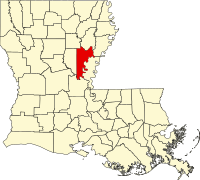Catahoula Parish, Louisiana
| Catahoula Parish, Louisiana | |
|---|---|
 Location in the U.S. state of Louisiana |
|
 Louisiana's location in the U.S. |
|
| Founded | March 23, 1808 |
| Named for | Tensas word for big, clear lake |
| Seat | Harrisonburg |
| Largest town | Jonesville |
| Area | |
| • Total | 739 sq mi (1,914 km2) |
| • Land | 708 sq mi (1,834 km2) |
| • Water | 31 sq mi (80 km2), 4.2% |
| Population (est.) | |
| • (2015) | 10,147 |
| • Density | 15/sq mi (6/km²) |
| Congressional district | 5th |
| Time zone | Central: UTC-6/-5 |
| Website | louisiana |
Catahoula Parish (French: Paroisse de Catahoula) is a parish in the U.S. state of Louisiana. As of the 2010 census, the population was 10,407. Its seat is Harrisonburg, on the Ouachita River. The parish was formed in 1808, shortly after the United States acquired this territory in the Louisiana Purchase of 1803.
Catahoula Parish was the home to many succeeding Native American groups in the thousands of years before European settlements began. Peoples of the Marksville culture, Troyville culture, Coles Creek culture and Plaquemine culture built villages and mound sites throughout the area. Notable examples include Peck Mounds, and the Troyville Earthworks. The Troyville Earthworks have components dating from 100 BCE to 700 CE during the Baytown to the Troyville-Coles Creek periods.
It once had the tallest mound in Louisiana at 82 feet (25 m) in height; it was the second-tallest mound in North America (after Monk's Mound at Cahokia Mounds). This mound was destroyed to make way for the Jonesville bridge over the Black River.
This area was settled primarily by migrants from the southern United States after the Louisiana Purchase, when the US acquired the vast, former French-claimed territory west of the Mississippi River. White migrants to north and central Louisiana were from the South, and were mainly of British descent and Protestant religions. They brought a new influence into Louisiana. Some also brought or purchased African-American slaves to work on larger plantations. Many of these were from the Upper South, which sold slaves through the domestic market. They brought their own cultural influences as well.
...
Wikipedia
